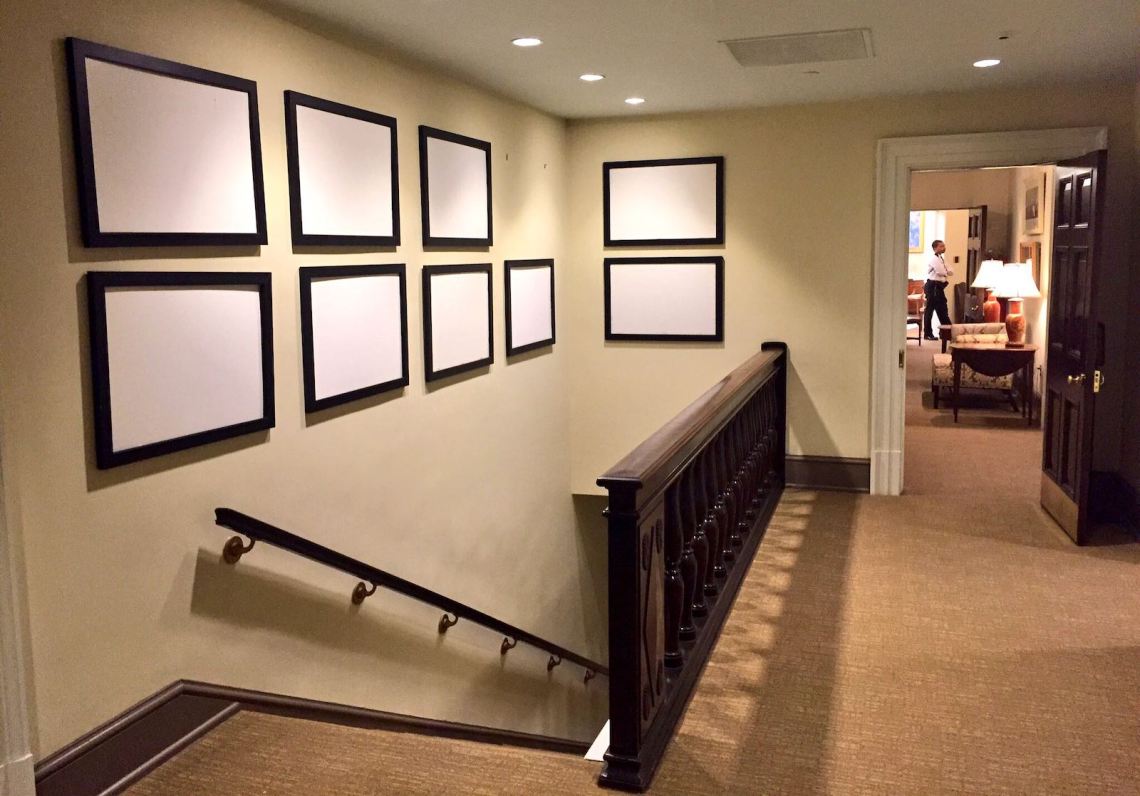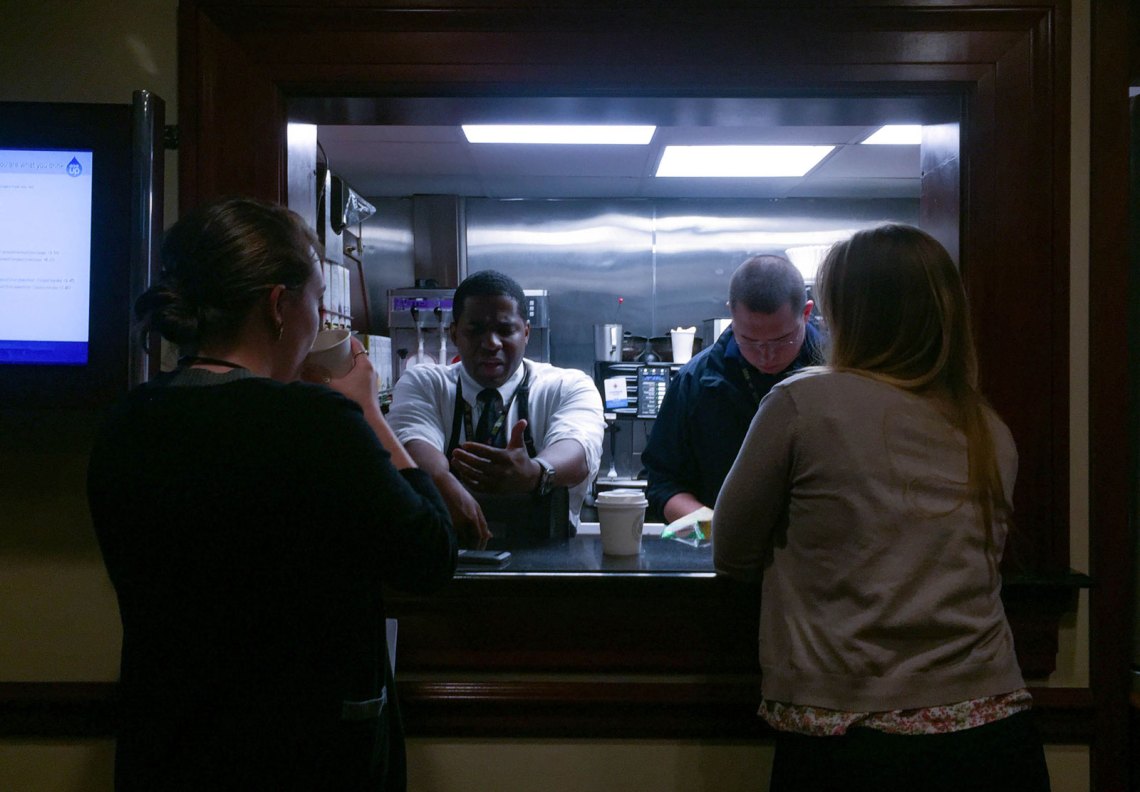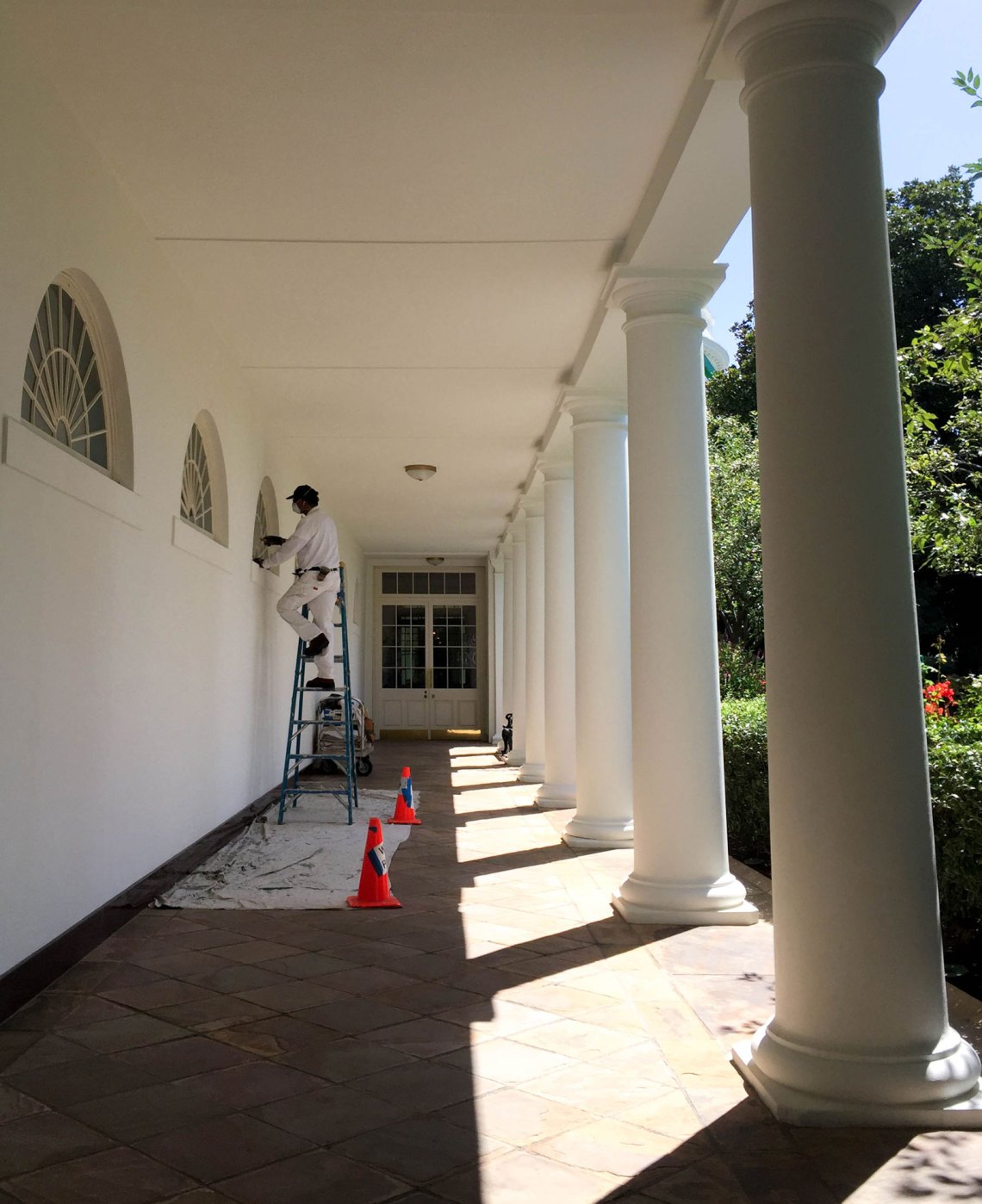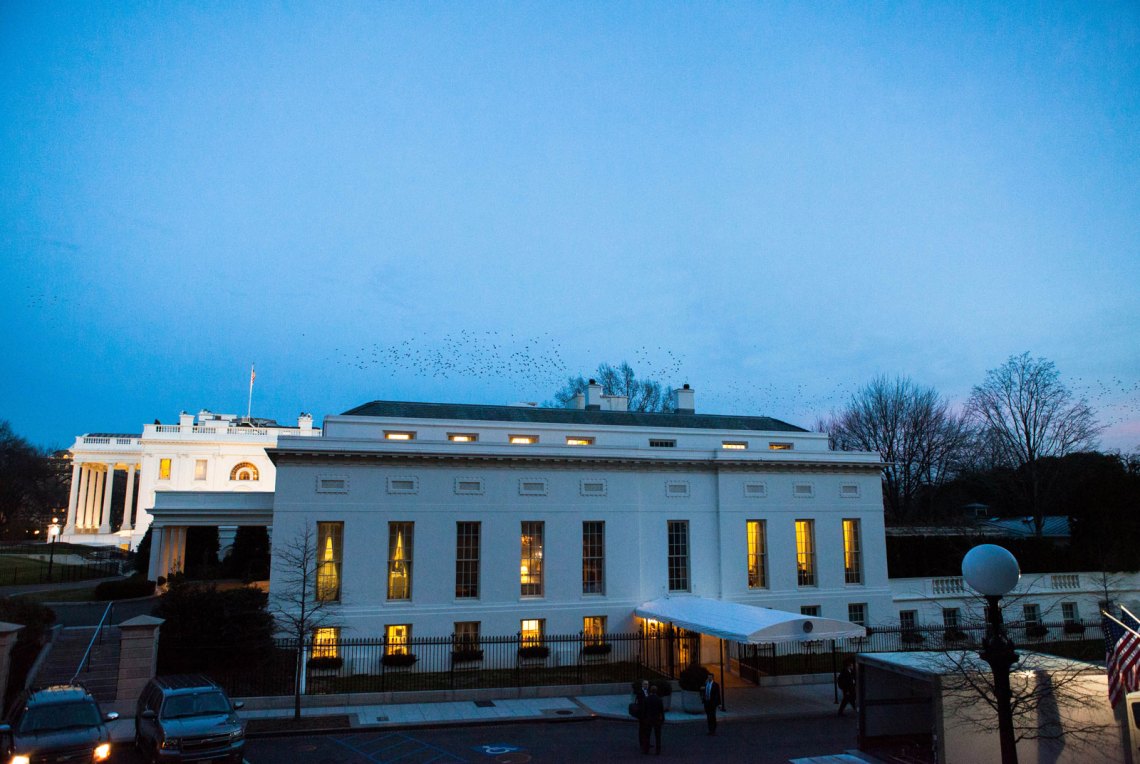Lately, I wonder what’s left of the old West Wing, and how it might feel to set foot there again. Spacious and light-filled in its television appearances, the real West Wing on Pennsylvania Avenue has low ceilings, fraying electrical wires, and cramped quarters, and is inhabited by gangs of flies, and bold, darting mice. It has workaday smells: the president’s lunch cooking on a hot plate in a closet off the Oval Office, exhaust fumes from Marine One pushing off from the South Lawn, and, on occasion, the smell of one of those mice, departed and decaying in the walls of the Situation Room; and another time, a faint burning smell coming from the ceiling, caused by an electrical fire. “The president is literally not in the Oval because it smells like someone lit a tire on fire,” a junior aide reported out at the time.
For three years I worked there. As an assistant speechwriter to Barack Obama, I shared a windowless office wedged into the slope of the South Lawn. I loved the West Wing. Its ordinary trappings suggested, rightly, a place of working people. Its tight quarters put the work of the presidency on a human scale, giving daily life inside an intimacy, a sense of possibility, and humor. The building’s agedness made its history inescapable and suggested my own personal transience. The haphazard refurbishments and wear and tear of past administrations were all around, but I was most sensitive to working in a building envisioned by Franklin D. Roosevelt, the last person to undertake a major renovation of the West Wing. The present-day West Wing persists as an enduring metaphor for FDR’s courageous vision of the American presidency.
In July, Donald Trump asked Senate Republicans to earmark $377 million in pandemic relief funds to gut-renovate the West Wing. If Trump loses, his proposed renovation seems less likely to happen, but the threat alone has symbolic power: Trump’s reconfiguring beyond recognition the last vestiges of a building made in FDR’s mold, and perhaps of the office of the presidency, too. If the Trump administration ever ends, I hope its memory puts a lasting dent in the romance of the American presidency. It is a national romance, or fixation, always guaranteed to serve a storyline, but more exceptionally does that romance serve the American people—the thought tempers my own reminiscing about the West Wing. But as the election draws close, I find myself returning there in my mind, believing in the building’s metaphoric power.
When I worked there, I delighted in observing how the West Wing’s modesty impressed newcomers. Once, my father—a Republican who had railed against government excess all my life—came to visit. He picked at my wood-laminate desk and declared, with pleasant surprise, “cheap shit.” In the spring of 2015, a delegation of Gulf state leaders visited the White House. While the heads of state met with Obama, their entourages waited floors below, in the West Wing’s White House Navy Mess, a dining room no larger than a two-car garage. They drank coffee from paper cups coated in Styrofoam and studied the sturdy institutional carpet underfoot with seeming bewilderment. I toured my roommate’s parents, visiting from Ukraine, through the West Wing’s halls. With few words, they admired the building’s simplicity and the photographs on the walls. At the end, Tatyana’s mother, self-conscious about her English, asked just two questions: “What does the president take for drink?” and “Who cleans these offices?”
Erstwhile occupants were moved by it, too. One August afternoon, I brought Jimmy Carter’s former aide Gerald Rafshoon to the West Wing. He gazed in through the doorway of the Oval Office and, as if transported to the last days of the Carter administration and re-living the presidency-ending Iran hostage crisis, he whispered, “If only we’d spent the campaign money on three more Apache helicopters.”
When they arrived in 2017, Trump and his staff were reportedly unimpressed by the flies and the West Wing’s overall, government-issue look. Shortly after the election, Jared Kushner told the Obama aide touring him around that the West Wing “looked like one of the president-elect’s golf course clubhouses.” They’ve worked on that: piecemeal renovations started soon after they arrived. Helpfully, Trump replaced the West Wing’s wheezing HVAC system, which sent odd drafts through its otherwise airless halls—one never knew if the homeland security adviser’s closed door indicated a temperature control issue or a national emergency. Other changes were largely cosmetic: as well as a wide flat-screen TV, Trump added a glass chandelier to his private dining room, off the Oval Office. “Look, I made a contribution to the White House,” he told reporters, adding, “We found gold behind the walls, which I always knew.”
Advertisement
Trump redecorated the Oval Office in cartoon fashion, all yellows and gilt. He had workers carpet the West Wing’s hallways in plush gray, and hang gaudy, eagle-adorned matching curtains, limp and heavy on the windows. They spray-painted gold the black plastic photo frames called jumbos that hang on the West Wing’s walls displaying the White House photographer’s most recent pictures of the presidency. In the press office, they rolled out rich blue carpeting and covered desks in faux-marble contact paper. They gutted and renovated the kitchens of the Navy Mess, and the Kennedy-era wood-paneled dining rooms where senior staff and guests lunch. They re-did the previously institutional-looking bathrooms, I’m told, in marble and gold trim, and added light fixtures throughout. To the downstairs foyer, they added a wall of personal lockers like those in the women’s changing room in the Georgetown Equinox, after Trump’s former Chief of Staff John Kelly banned personal phones in the office to prevent leaks. Earlier this summer, Melania Trump renovated the Rose Garden, uprooting the tulips that stood so straight as to look stuck-in, and making it more accessible—to people with disabilities, but also, especially, to television camera crews.
In truth, a major renovation of the West Wing of the scale Trump has proposed is long overdue. The political optics of self-interest and excess, and the annoyance of moving, dissuaded Trump’s predecessors, including Obama, from taking it on, but the building sags and leaks, and its deteriorating wiring is the bane of every IT technician trying to deliver consistent Internet in a now-or-never atmosphere.
I hope Trump will not oversee the renovation he wants, and that any future one will preserve, in form and attitude, FDR’s touches, which were everywhere I turned. During his twelve-year presidency, Roosevelt had the fieldstone colonnade lining the Rose Garden graded so that he could wheel to work each morning. He moved the Oval Office, so it overlooked the Rose Garden, giving that room its present-day, breathtaking light, which streams in from the South Lawn, so bright as to make standing there feel unreal. A daily swimmer, he installed the White House’s first pool. Today, the empty, aqua-tiled chamber houses the television networks’ mass of humming transmission equipment. During the FDR expansion, architects added a courtyard at the base of a windowed pit in the ground, so that the staff who occupied the offices down there would not be exiled from daylight. By the time it became the cramped quarters of Obama’s speechwriters, the light well had been filled in, and we worked oblivious of the weather outside or time of the day.
FDR also saw his changes to the building as symbolic of his transformation of the office, too. Before leaving for his summer vacation, when the work of renovation would begin, he delivered one of his fireside chats, in which he promised to protect the “artistic lines” of the White House. “The necessities of modern government business require constant reorganization and rebuilding,” he said, going on:
The architects and builders are men of common sense and of artistic American tastes. They know that the principles of harmony and of necessity itself require that the building of the new structure shall blend with the essential lines of the old. It is this combination of the old and the new that marks orderly peaceful progress—not only in building buildings, but in building government itself.
I remember not only how the West Wing looked, but the feeling of inhabiting it—the rush and effort followed by slowness, the ordinariness and humor part of life’s pace there. I think often of the people who came with the building, and those who work there still—their West Wing tours of duty are not term-limited, nor are they much memorialized. The National Park Service painters brushing white varnish over accumulated fingerprints on the doorframes of the West Wing, where people had rested their hands. When the touch-up paint grew so thick around an Oval Office doorframe, and had to be scraped off, I asked one painter why he didn’t simply wipe off the prints instead. “I’m a painter, not a cleaner,” he told me matter-of-factly, and kept working. The young Secret Service officer standing guard at the Pennsylvania Avenue gate, part of an overworked corps of new recruits pulling twelve-hour shifts, six days a week. One morning, I put my umbrella through the metal detector tip first, and it nearly impaled him. When I apologized, he told me, half-smiling, “It’s okay; I’d get two paid weeks off.” The sailors working the takeout window in the West Wing’s Navy Mess, affecting a take-it-as-it-comes attitude toward the daily onslaught of harried, self-important West Wing staffers. One afternoon, I watched John Kerry emerge from a meeting in the Situation Room next door, holding a plastic binder stuffed with papers. He tapped the countertop restaurant bell twice, craning his neck into the pass-through, straining for attention. “Hello?” Kerry called, with urgency. “What’s the yogurt flavor of the day?”
Advertisement
With the election days away, I remember with fresh dread the strange and haunting way it felt at the end of Obama’s administration: the West Wing began to feel “like a beach ball someone sat on,” a colleague said at the time. And then there was the morning of November 10, 2016, when Obama received Trump in the Oval Office. “For any given thing, there were always more than enough people who wanted to come,” an Obama aide told me. “This, no one wanted to experience.” When it became apparent that Trump—already en route to the White House in a Secret Service motorcade—was some minutes ahead of schedule, an Obama aide asked the team to “slow-roll” it. Somehow, atypically, the request went unanswered, a faint signal of the tectonic shift to come, the beginning of the end. The president and his two aides hurried along the colonnade to greet the president-elect in the diplomatic reception room, where he arrived early.
A month later, when Obama delivered one of his last press briefings, he made a tired attempt to list his achievements as president, but soon he relented to reporters’ questions about what he knew and had done to stop Russia from interfering in the 2016 election. In the heat of the lights amid the jam of people, one reporter fainted. Standing at the podium, the president asked for the White House doctor, Ronny Jackson. Long, televised minutes passed, and Dr. Jackson did not appear.
I watched the scene unfold on a thirteen-inch monitor mounted on the wall of my West Wing basement office. Obama looked so alone. He continued standing at the podium, eyes and lenses glued on him and his impatient expression. “Is somebody grabbing our doctor?” Finally, he began giving directions to Dr. Jackson’s office, as if preparing to walk there himself. “Do you guys know where the doctor’s office is? Just go through the Palm Room doors, it’s right next to the Map Room,” he said.
I watched Obama’s polite impatience grow with each passing moment as Dr. Jackson failed to appear. Maybe no staffers outside the Briefing Room were watching, I thought, in panic. I darted from my office, past the closet where, I had been told, aides once stored the recording equipment for FDR’s Oval Office press conferences, and bounded up the steps two at a time to the press offices, a short walk from the briefing room. The aides I found there were transfixed in horror, but just then, at last, Dr. Jackson showed up.
“There he is,” Obama said. And here he was again, this past May, now running as Republican candidate for Texas’s thirteenth congressional district, and tweeting, “President Obama weaponized the highest levels of our government to spy on President Trump.”
“All right, there’s Doc Jackson,” Obama said, letting go his irritation. “He’s all right. OK, the doctor is in the house.”





